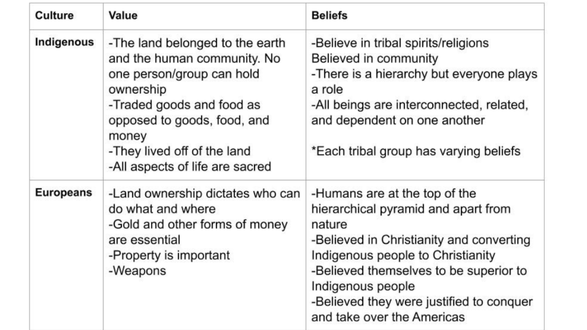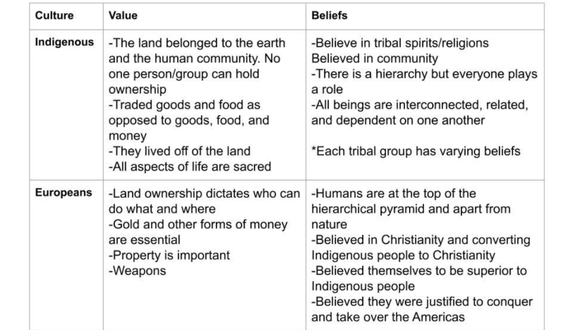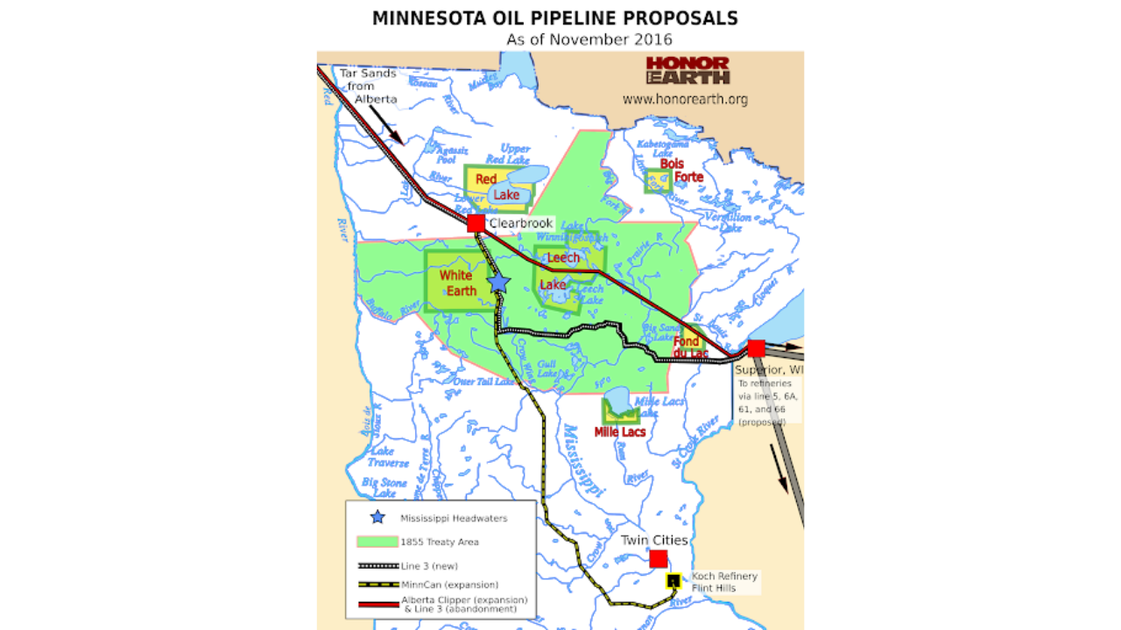
Minnesota is home to 11 sovereign tribal nations. Indigenous communities don’t follow modern European notions of nationality and territory. Indigenous communities also value land, life, and the Earth in varying ways; each Indigenous community may practice appreciation and respect for the planet in unique ways. Many Indigenous groups also do not adhere to the idea of property or owning land like Europeans do. The idea that one can own the land beneath one's feet is more integral in European culture. There is however, more focus on traditions and practices that can improve the land beneath one's feet, even if one is utilizing something provided by the land. There is a more personal relationship to land in Indigenous cultures, overall.

Treaties between Tribal governments and the United States government have resulted in ceded land used by Indigenous tribes in return for resources, supplies, and money. However, tribal members have always had the right to hunt, fish, and gather food in the ceded territories. The treaties are written documents that further protect the existing rights of Indigenous groups.
It is very important to understand the history associated with the land and the Indigenous communities who live and have lived on and utilized the land. The history for the Arrowhead region is rich and centers on four communities. The Dakota, Ojibwe, Cree, and Assiniboine lived near the Fond du Lac and Lake Superior region. Over time, the Dakota migrated to the prairies and plains to the southwest while the Ojibwe people migrated westward. By the mid-1700's, Ojibwe communities migrated to Duluth. However, the Ojibwe people of the Arrowhead Region and European governments had relationships before the United States government sent representatives following the outcomes of the War of 1812.
The first interactions between Indigenous people and Europeans in the area known as Minnesota started with fur trading in the 1600's. The French fur trade led to a strong culture shift towards the Indigenous people, as they received guns, knives, liquor, cloth, and other goods in exchange for furs. These other goods were created from glass, porcelain, and iron, replacing pottery and traditional tools made of stone. The French maintained a mainly amicable relationship with the Ojibwe people; Ojibwe communities sided with the French during the wars of 1689 and 1763. Following the war of 1763, the Treaty of Paris claimed that the British could occupy and manage the land east of the Mississippi River and its headwaters. At the end of the American Revolutionary War, the 1783 Treaty of Paris claimed the United States could manage and occupy land in northeast Minnesota.
The beginning of the 1800's presented major changes in the lives of Indigenous people and Europeans in the Arrowhead Region. Land cession treaties with the Dakota and Ojibwe were established in 1837; establishing that territory east of the Mississippi River and below the Crow Wing River became available for white settlement.
The 1847 Treaty of Fond du Lac was the first of two treaties for the purpose of acquiring land along the Mississippi. The land was near Long Prairie, as the Ho-Chunk were removed from their homelands in Wisconsin. The first treaty declared the concession of Lake Superior and some Mississippi bands of Ojibwe; the second treaty was with the Leech Lake Pillagers.
The 1854 Treaty of La Pointe transferred land title to lands in the Arrowhead region and created reservations for permanent residence of Ojibwe people throughout all ceded land. Chief Buffalo also reserved lands for himself in what became Duluth. This treaty is incredibly important, along with all other treaties. In particular, the Treaty of La Pointe assumed that those living in ceded lands would not have to move or be removed. The following year, the 1855 Treaty with the Chippewa (Ceded Territory Treaty) of the Mississippi, Pillager, and Lake Winnibigoshish bands resulted in the cessation of much of the remaining lands of northern Minnesota to the United States and the creation of nine reservations.
Throughout the treaty period, Ojibwe families continued to pursue their traditional way of life both within their reservations and in the ceded lands surrounding them. Ceded territories are areas off of designated reservations where Indigenous people have certain property rights that allow them to “make a modest living from the land", otherwise known as usufructuary rights. These rights are established by the treaties between Indigenous communities and the United States government and are protected by the United States Constitution and the United States Supreme Court. These rights include the right to hunt, fish, harvest and cultivate wild rice, forage medicinal plants, and the right to preserve sacred or culturally significant sites.
Currently and throughout history, the ideologies of Indigenous people and European people (and other colonist/exploitive travelers) have clashed. This lack of harmony has led to many imbalances and atrocities against Indigenous people. The source for violence from Europeans in North America was the overly intense desire for the vast resources and new-to-Europeans land opportunities. However, Blair Stonechild, author, professor, and program coordinator of Indigenous studies at First Nations University of Canada states, "The roots of this ideological divide go well beyond European contact with North America. The rift actually occurs at the point of the rise of civilization, at which time humanity decided to dominate nature."
Stonebird contends further, "Endless resource exploitation, economic growth and population expansion are unsustainable. Unfortunately, our current systems do not seem capable of planning for or dealing with such challenges. Our collective failure to deal with climate change is a prime example." More specifically, many Indigenous groups express concern over pipelines and other perpetrators of climate change.
The Enbridge Line 3 pipeline was constructed in 1962, and began pumping oil in 1968. The pipeline has over 900 anomalies, which include cracks, splits, leaks, or other pipeline damages.
There was a spill in 1979, spilling 449,000 gallons. In 1991, the pipeline caused the largest-ever inland oil spill of all time near Grand Rapids; 1.7 million gallons spilled. In 2002, there was another oil spill, and in 2007, there was a deadly fireball eruption.
In 2013, Enbridge started planning for a larger, more expansive pipeline to "replace" Line 3. This project would be larger and more expansive than the original Line 3, and the original pipeline would be abandoned. The new pipeline would also be tasked with pumping tar sands oil throughout the area. Tar sands, or sand most often from sandstone, can be made into crude oil. This oil is less energy-rich and has more "other" ingredients than conventional oil from oil reserves.
The federal government of Canada approved construction in Canadian territory in 2016. In 2017, the Minnesota Public Utilities Commission stated the area would be better without the pipeline. However, on June 28th, 2020, the Minnesota Public Utilities Commission made an illegal decision to grant the certificate of need to Enbridge for their proposed Line 3 project.
However, all other state agencies that have reviewed the project have made it clear there are concerns that must be addressed. The Minnesota Pollution Control Agency is concerned about the proposed route and the susceptibility of the aquifers to pollution. The Minnesota Department of Natural Resources also believes the proposed route is concerning, in addition to being concerned by the Department of Commerce's environmental impact statement. The Department of Commerce's assessment found no need for the project, recommending the pipeline not be permitted. Also, Judge Ann O'Reilly found that the route should not be permitted and expressed concern about Enbridge’s proposed abandonment of the original Line 3 pipeline.
Enbridge plans to expand projects across the Great Lakes Region. If Line 3 is constructed throughout Minnesota, there are future Enbridge projects planned in Wisconsin and Michigan. Enbridge plans to expand the Wisconsin southern route to the Gulf of Mexico. Enbridge also plans to abandon the existing line passing through the lake bottom of Mackinaw Straights to build a larger pipeline underneath the lake.
Part of why this project has so much controversy is due in part to the concerns for Indigenous life. As shown by the map, the proposed project would run through several Indigenous territories. The Kalamazoo River Spill in 2010 and the continued risky operation of Line 5 has upset many in Michigan. Local governments and tribes are taking action for an immediate halt of operations and to cancel any existing easements for the project.
The issue with land and ownership in regards to the Line 3 project is even more concerning to Indigenous groups due to the lack of acknowledging tribal sovereignty. The Indigenous communities in the proposed path of Line 3 oppose the project. Ignoring the opposition is a violation of sovereignty. Sovereignty is the right to self-determination and self-government guaranteed to tribal nations by the United States Constitution and upheld by the United States Supreme Court.
The Indigenous groups have made it clear they do not consent to the project and the State of Minnesota also does not have jurisdiction in ceded territories. Stop Line 3, an activist group, claims that the dismissal of Indigenous communities is modern-day colonialism for the purposes of resource extraction and corporate profit. Their website states, "Where there is wild rice, there are Anishinaabeg, and where there are Anishinaabeg, there is wild rice. It is our sacred food. Without it we will die. It’s that simple."
Ignoring the Indigenous communities adds to the aforementioned environmental concerns of the Line 3 pipeline. The map below shows that Line 3 is proposed to run through the White Earth Reservation and would be constructed near many watersheds throughout Minnesota, including the St. Louis River. The abandoned pipeline runs through the Leech Lake Reservation and the Fond du Lac Reservation, as well as the Mississippi Headwaters and Mississippi River.

Across the globe, Indigenous people are the most impacted by climate change and the problems it is causing, even though they contribute relatively little to the emissions that are causing it. This is because overall, Indigenous people are more closely tied to the land, and therefore more dependent on a healthy ecosystem and healthy natural resources to survive.
If interested in learning more about efforts in favor of halting Line 3, consider these sources:
Honor the Earth water protectors
Thanks to Native Land, a map of the varying Indigenous communities and the treaties arranged between them and European colonists is made available. (This map does not represent or intend to represent official or legal boundaries of any Indigenous nations. To learn about definitive boundaries, contact the nations in question.)